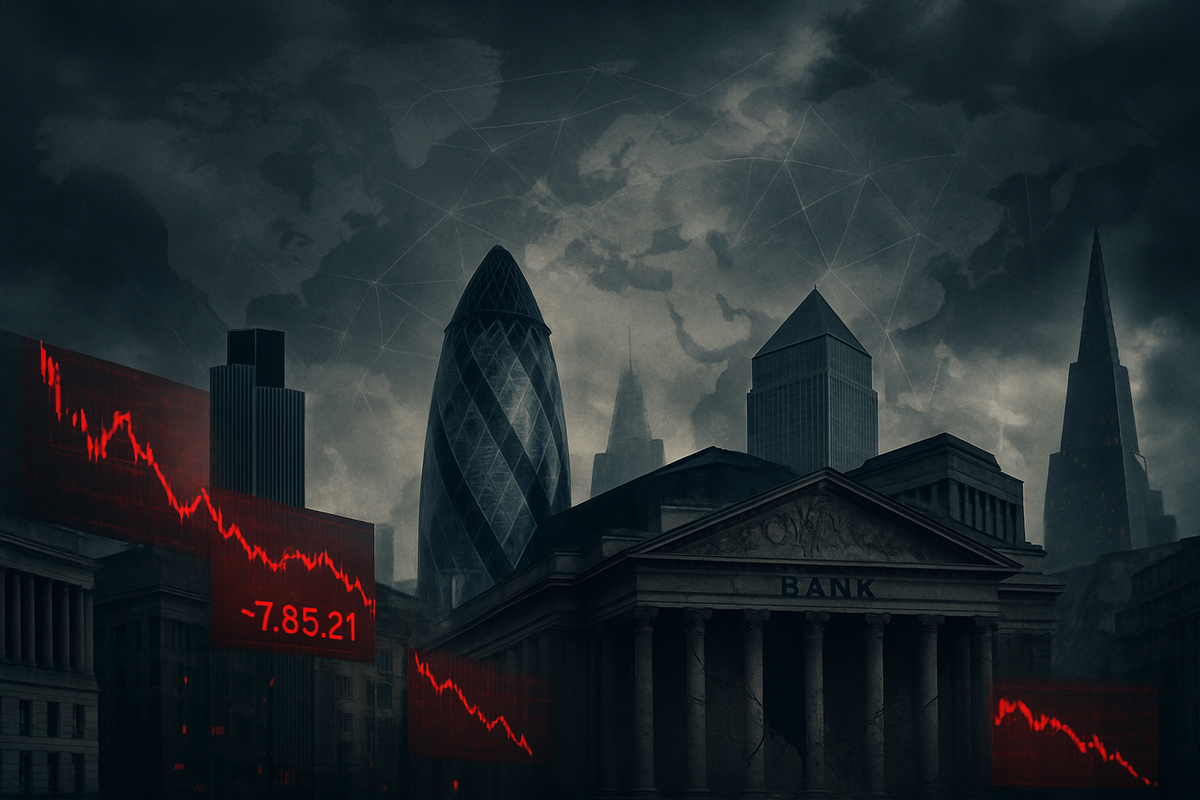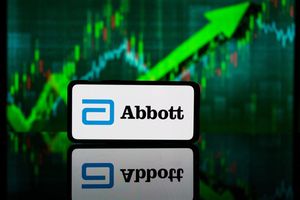
London's benchmark FTSE 100 index experienced a significant plunge on Friday, October 17, 2025, shedding between 1.4% and 1.6% of its value, marking its steepest one-day decline since April's tariff chaos. The sharp downturn was triggered by renewed anxieties stemming from the US regional banking sector, sending jitters across global equity markets and prompting a widespread flight to safety. This event underscores the persistent interconnectedness of the financial world and the fragility of investor confidence in an era of elevated interest rates and geopolitical uncertainty.
The immediate catalyst for the market's unease came from unsettling disclosures by two American regional lenders. Zions Bancorporation (NASDAQ: ZION) announced a $50 million charge-off related to problematic commercial loans, while Western Alliance Bancorp (NYSE: WAL) revealed it was pursuing legal action concerning a fraudulent borrower. These revelations, occurring against a backdrop of existing credit market fragility, immediately evoked painful memories of the regional banking distress seen in 2023, which included the high-profile collapses of Silicon Valley Bank (SVB) and First Republic Bank.
Detailed Coverage: A Ripple Effect Across Continents
The specific details emerging from the US regional banking sector quickly snowballed into a global market event. The disclosures from Zions Bancorporation and Western Alliance Bancorp, though seemingly isolated, struck a nerve with investors already wary of lending standards and credit quality following a prolonged period of elevated interest rates. This unease was compounded by recent failures of companies like car part maker First Brands and automotive credit lender Tricolor, both stemming from debt-related issues, further contributing to a broader reevaluation of credit market health in the US.
The timeline of events leading to this moment stretches back to the 2023 US banking distress. In March 2023, the collapse of Silicon Valley Bank (SVB) and Signature Bank (SBNY) highlighted vulnerabilities arising from interest rate risk and concentrated, uninsured deposit bases. This was followed by the failure of First Republic Bank (FRC) in May 2023, which was subsequently acquired by JPMorgan Chase (NYSE: JPM). Regulatory bodies like the Federal Deposit Insurance Corporation (FDIC) and the Federal Reserve responded with emergency liquidity measures, including the Bank Term Funding Program (BTFP), to stabilize the system. However, the October 17, 2025, plunge suggests that these concerns were merely dormant, not resolved.
Initial market reactions were swift and severe. European financial markets experienced a sharp downturn, with banking stocks across the continent bearing the brunt of the selling pressure. Major UK lenders such as Barclays (LSE: BARC), Standard Chartered (LSE: STAN), and NatWest Group (LSE: NWG) saw their shares plummet, with Barclays falling by as much as 6.75%. Asian markets also registered declines, with Japan’s Nikkei 225 falling 1.6% and Hong Kong’s Hang Seng dropping 2%. The CBOE Volatility Index (VIX), often called "Wall Street's fear gauge," surged to its highest point since April, reflecting a significant increase in market nervousness. Investors responded by fleeing risky assets, pushing gold prices to a new record high of over $4,300 per ounce, marking its most substantial weekly gain since the 2008 financial crisis, while government bond yields fell as demand for safer securities increased.
The comparison to "April's tariff chaos" is telling. That event, which began on April 2, 2025, was triggered by US President Donald Trump's announcement of sweeping new tariff policies, leading to an initial 3% drop in the FTSE 100 within minutes, followed by a near-5% wipeout and a further 4.38% decline over subsequent days. While both events caused significant market disruption, April's chaos was a direct economic policy shock threatening global trade, whereas the current plunge is a financial system stability shock driven by credit quality concerns. Both, however, underscore the market's extreme sensitivity to unexpected negative developments.
Companies on the Brink: Winners and Losers
The widespread market downturn and tightening credit conditions stemming from the US regional banking fears will undoubtedly create a distinct divide between potential winners and losers in the corporate landscape.
Potential Losers will predominantly be found within the financial sector itself. UK banks with significant exposure to US markets or interbank lending, such as HSBC (LSE: HSBA), Lloyds Banking Group (LSE: LLOY), Barclays (LSE: BARC), NatWest Group (LSE: NWG), and Standard Chartered (LSE: STAN), will face direct risks from potential US regional banking failures. Concerns about write-downs, increased provisions for bad loans, and tightening capital requirements will likely drive down their stock performance. Tighter credit conditions will also reduce lending opportunities, impacting net interest margins and overall profitability.
Beyond finance, cyclical sectors are highly vulnerable. Companies in consumer discretionary, industrials, and real estate are expected to suffer. For example, retailers like JD Sports (LSE: JD.) and Associated British Foods (LSE: ABF), which owns Primark, could see reduced consumer spending. Housebuilders such as Persimmon (LSE: PSN) and Taylor Wimpey (LSE: TW.) will be hit by tighter mortgage credit and reduced housing demand. Industrial giants like Rolls-Royce (LSE: RR.) and travel companies like IAG (LSE: IAG), owner of British Airways, will face reduced corporate investment and leisure travel. Any company with high debt levels will also be severely impacted, as higher perceived risk will lead to increased borrowing costs and potential difficulties in refinancing, eroding profitability and straining cash flow.
Conversely, a few sectors and companies may emerge as potential winners or prove more resilient. Defensive sectors such, as utilities, consumer staples, and healthcare, typically outperform during downturns. Companies like National Grid (LSE: NG.), SSE (LSE: SSE), Unilever (LSE: ULVR), Reckitt Benckiser (LSE: RKT), Diageo (LSE: DGE), AstraZeneca (LSE: AZN), and GSK (LSE: GSK) provide essential goods and services, meaning their demand is relatively inelastic. Investors often rotate into these sectors as safe havens, valuing their stable earnings and dividend payouts. Gold miners, such as Fresnillo (LSE: FRES), are also likely to perform strongly, as gold's status as a safe-haven asset drives up its price, directly benefiting mining companies. Finally, companies with strong balance sheets and high cash flow will be better positioned to weather the storm, having the financial flexibility to continue investing or even acquire distressed assets at lower valuations, potentially gaining market share from weaker competitors.
Wider Significance: Echoes of Past Crises
The FTSE 100's plunge, ignited by US regional banking fears, carries a wider significance that extends far beyond immediate market movements. It serves as a stark reminder of the global financial system's profound interconnectedness and its susceptibility to confidence shocks.
This event fits squarely into several broader industry trends. The current elevated interest rate environment continues to stress weaker borrowers and expose vulnerabilities in bank balance sheets, particularly those holding long-dated, low-yielding assets, much like the 2023 regional banking crisis. Furthermore, the prominence of Commercial Real Estate (CRE) vulnerability, with concerns over bad office loans and substantial CRE debt maturities, is a major factor contributing to credit quality issues, exacerbated by trends like remote work. The event also occurs amidst evolving regulatory scrutiny, with frameworks like Basel III Endgame (set for July 1, 2025) aiming to enhance stability, yet the crisis highlights the ongoing need for "smarter regulation" for both traditional and non-bank financial institutions.
The ripple effects on competitors and partners will be substantial. A widespread regional banking crisis in the US could lead to tighter lending standards globally, impacting all financial institutions and potentially triggering a credit crunch. Small and Medium-sized Enterprises (SMEs), heavily reliant on regional lenders, would be disproportionately affected, stifling economic growth. Technology companies and startups, as seen in the 2023 SVB collapse, could face restricted access to capital, threatening innovation. Globally, companies reliant on complex supply chains may face increased costs and disruptions due to heightened economic uncertainty.
In terms of regulatory or policy implications, central banks, acting as lenders of last resort, would likely provide emergency liquidity support. The event would trigger renewed calls for more thorough auditing and stress tests for banks, focusing on asset valuations and interest rate risk. Regulators might expand deposit insurance or guarantee all deposits to prevent widespread bank runs and maintain public confidence. Given the global nature of the ripple effects, international coordination among central banks and financial authorities would be crucial.
Historically, this event draws parallels with both the 2008 Financial Crisis and the more recent 2023 US Regional Banking Crisis. While the 2008 crisis was driven by subprime mortgages and an underlying weak economy, the current scenario, like 2023, is more linked to interest rate risks and specific asset classes like CRE. Post-2008 reforms have generally left banks more capitalized, but some studies suggest funding risks associated with deposits have increased, raising concerns that current risks might even exceed 2008 levels. The Savings and Loan crisis of the 1980s and 1990s, fueled by high interest rates and risky CRE lending, also serves as a poignant historical precedent, consistently demonstrating that periods of rapid credit growth followed by sharp interest rate increases can precede banking crises.
What Comes Next: Navigating the Uncertainty
The path forward for global financial markets, following the FTSE 100's plunge due to US regional banking fears, is fraught with both challenges and potential opportunities, demanding strategic pivots from institutions and investors alike.
In the short-term, market volatility is expected to remain elevated, with further price swings likely as investors digest new information and assess the extent of contagion. The flight to safety will persist, with gold, government bonds, and stable currencies continuing to attract capital. A tightening of credit standards, particularly for commercial real estate, is highly probable, potentially hindering growth for small and medium-sized businesses. The banking sector, globally, will remain under intense scrutiny, facing increased pressure on loan loss provisions and liquidity management.
Long-term possibilities include a potential prolonged economic slowdown if the banking crisis leads to a significant credit crunch and reduced investment. This event will almost certainly accelerate regulatory scrutiny and reform, with governments and central banks intensifying efforts to strengthen financial stability through tighter capital requirements, enhanced stress testing, and stricter supervision, especially for non-bank financial institutions. The investment landscape may shift, favoring more resilient, defensive sectors and sustainability-focused investments, while financial institutions may continue to de-risk their balance sheets and diversify revenue streams.
Strategic pivots for financial institutions will include bolstering risk management frameworks with advanced modeling and environmental scanning, prioritizing liquidity and capital preservation, diversifying loan portfolios away from vulnerable sectors, leveraging big data and analytics for risk prediction, and close regulatory engagement. Other affected companies must focus on strengthening financial planning and liquidity, managing debt, diversifying revenue streams and supply chains, reducing costs, and focusing on core, resilient business models.
Market opportunities may emerge for value investors seeking undervalued assets with strong fundamentals, low debt, and good cash flow. Defensive sectors, dividend-paying stocks, and safe-haven assets will remain attractive. Furthermore, businesses that invest in technological advancement and digital transformation can improve efficiency and adaptability, while struggling businesses might become targets for mergers and acquisitions. However, significant challenges include persistent market volatility, tightening credit conditions, increased regulatory burdens, eroding consumer confidence, ongoing geopolitical risks, and the difficult balancing act central banks face between combating inflation and supporting financial stability.
Potential scenarios range from a contained correction and gradual recovery, where swift and coordinated central bank action prevents widespread contagion, to a prolonged stress and mild recession, if the regional banking fears prove more systemic. In a worst-case scenario, a systemic crisis akin to 2008 could lead to a deep global recession, widespread bankruptcies, and significant job losses, potentially requiring unprecedented central bank interventions and fundamental changes to the global financial architecture.
Wrap-up: Vigilance in a Fragile Market
The events of October 17, 2025, serve as a potent and unwelcome reminder of the inherent fragility within the global financial system. The FTSE 100's sharp decline, catalyzed by specific issues in the US regional banking sector, underscores how quickly localized concerns can escalate into international market dislocations.
Key takeaways include the immediate and direct contagion effect from US regional banks, the widespread global market reaction demonstrating interconnectedness, the underlying vulnerability of the broader banking sector to confidence shocks, and the renewed flight to safe-haven assets like gold. The episode also reignites critical questions about credit market health, particularly regarding commercial real estate exposure and the lingering effects of elevated interest rates.
Moving forward, the market remains in a highly sensitive state. The immediate concern is the potential for further negative disclosures or a broader credit crunch. Regulatory bodies will be under immense pressure to monitor risks closely, and their policy decisions will be pivotal in containing potential contagion. Expectations for monetary policy, particularly from the Federal Reserve, may shift towards easing to support stability, potentially impacting currency markets. The underlying health of the economy, especially lending practices and emerging credit losses, will be a central focus.
The significance and lasting impact of this event could be profound. It risks eroding confidence in financial institutions, potentially stifling economic growth through tighter credit conditions, and catalyzing further regulatory reform to enhance transparency and stability. Historically, such financial tremors have often led to shifts in global economic power dynamics.
For investors in the coming months, vigilance and a focus on resilience are paramount. Maintaining a well-diversified portfolio across asset classes and geographies is crucial. Investors should prioritize fundamental analysis, focusing on companies with strong cash flows, low debt, and robust risk management practices. Patience is key; attempting to time market bottoms is often futile. Preserving liquidity provides "dry powder" for opportunities that may arise during market turmoil. Additionally, closely monitoring key economic indicators, central bank pronouncements, and regulatory actions will be essential for navigating the uncertain landscape. The events of October 17, 2025, reinforce that while immediate issues might seem contained, the interconnected nature of global finance demands continuous vigilance and robust risk management from all market participants.
This content is intended for informational purposes only and is not financial advice






